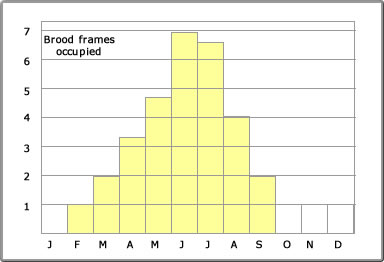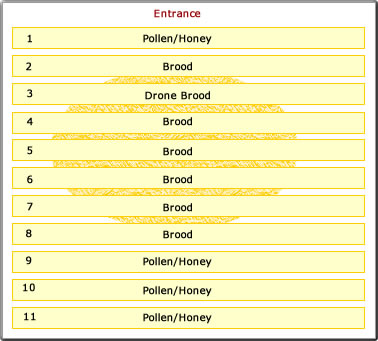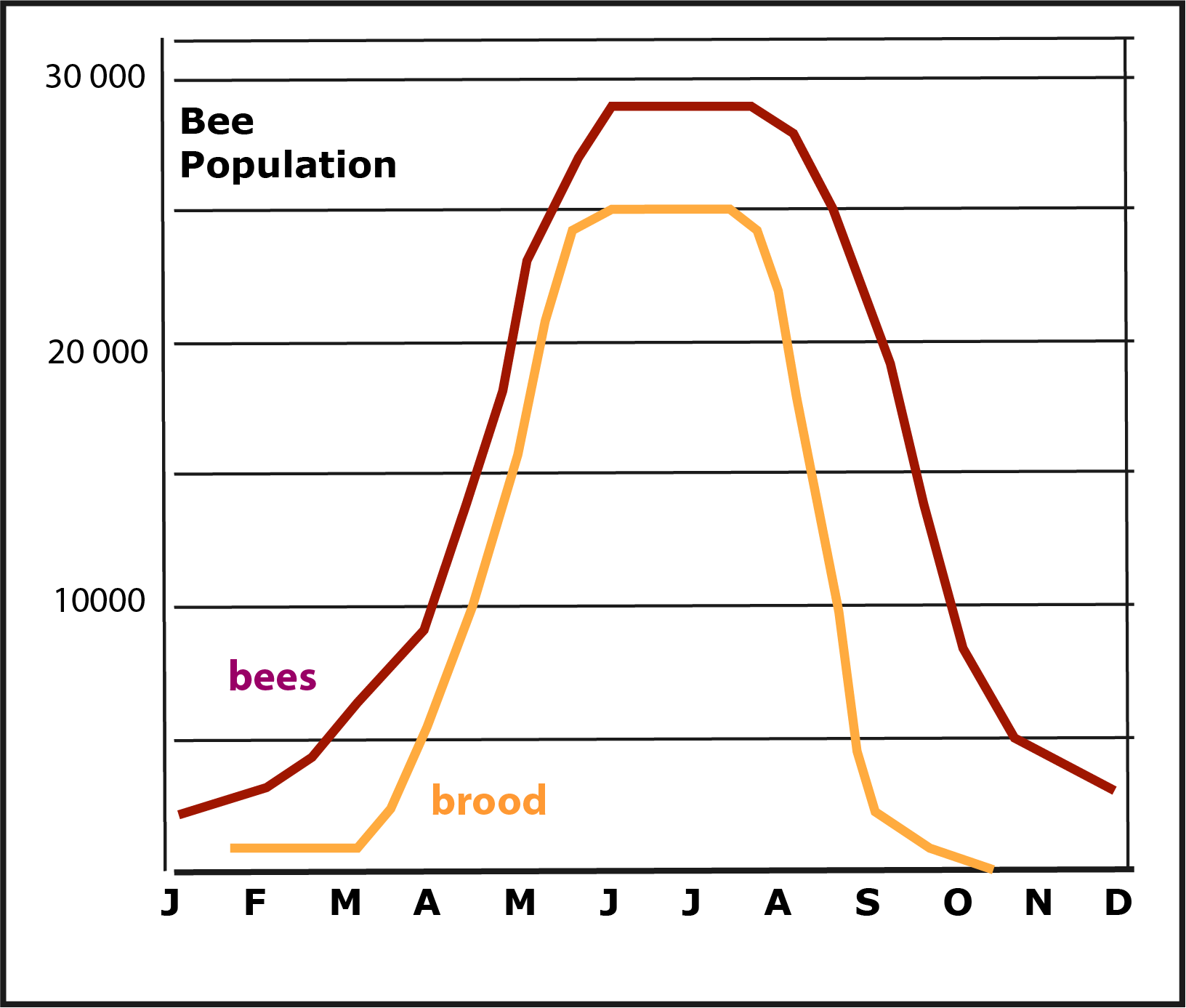
Brood
Annual brood cycle
The annual brood cycle of the black bee is in tune with the climate and adapts to the local flora(14). The cycle is typified by a slow spring build up and the early cessation of egg laying in late summer by the queen.
Local nectar of any quantity only becomes available in April with the first dandelions. The early spring build up is then dependent on the bees using their winter stores. It is therefore essential to ensure that these are still present hence the importance of autumn feeding. These bees are not fed in the springtime.
The cessation of egg laying(12) by the queen in late summer ensures that the autumn fed sugar is not turned into brood but is stored together with copious amounts of pollen for the winter.
At this time the bee themselves are taking in large amounts of pollen(11) to ensure that some of them are able to survive until the next spring i.e. become winter bees.
For some actual scenarios see Brood Area in the above menu.
Local nectar of any quantity only becomes available in April with the first dandelions. The early spring build up is then dependent on the bees using their winter stores. It is therefore essential to ensure that these are still present hence the importance of autumn feeding. These bees are not fed in the springtime.
The cessation of egg laying(12) by the queen in late summer ensures that the autumn fed sugar is not turned into brood but is stored together with copious amounts of pollen for the winter.
At this time the bee themselves are taking in large amounts of pollen(11) to ensure that some of them are able to survive until the next spring i.e. become winter bees.
For some actual scenarios see Brood Area in the above menu.
The bar chart above shows the approximate number of frames containing brood per month. In the months from October to February no brood may be present.

The 11 frames are arranged the 'warm way' in the National hive i.e. parallel to the entrance. The brood nest is formed above the entrance. In the spring build up the brood nest expands towards the back of the hive. The first frame contains stores; the first brood frame is usually the second frame. A frame for drone brood
is placed in the third position in early April.
It has been found that one National brood box is sufficient to accommodate the colony i.e. this would confirm that these black bees shown a non-prolificacy (9).
In the preparation for winter the brood nest contracts and the 'summer' brood frames are filled with winter stores. The bees initially form a tight cluster above the entrance(15), but as these stores are consumed the cluster moves into the body of the hive to find more stores. This is one advantage of having the frames arranged the 'warm way.
Arranging the frames the cold way (at right angles to the entrance) can result in 'isolation starvation'. Here the bees move left or right with regards to the entrance seeking their honey stores. Only to run out not realizing there is still honey available on the other side of the hive.
It has been found that one National brood box is sufficient to accommodate the colony i.e. this would confirm that these black bees shown a non-prolificacy (9).
In the preparation for winter the brood nest contracts and the 'summer' brood frames are filled with winter stores. The bees initially form a tight cluster above the entrance(15), but as these stores are consumed the cluster moves into the body of the hive to find more stores. This is one advantage of having the frames arranged the 'warm way.
Arranging the frames the cold way (at right angles to the entrance) can result in 'isolation starvation'. Here the bees move left or right with regards to the entrance seeking their honey stores. Only to run out not realizing there is still honey available on the other side of the hive.
The diagram above shows the mid summer brood pattern in a hive with 11 frames. Frames 9, 10, and 11 may not be occupied by brood but are used for the storage of pollen and honey. Frame 3 is a special frame for drone brood.
The brood nest in summer

It takes 21 days from the laying of the egg to the emergence of the worker. A further 21 days are spent in the hive as a house bee before the worker bee goes out to forage. As a house bee the worker is employed in a multitude of tasks: cleaning, feeding larvae, repairing and preparing cells for the queen to lay, passing food, and storing honey and pollen etc. The life span of a foraging worker is about 6 weeks.
Hive population

The diagram attempts to summarize the relationship between the amount of brood and the hive population throughout the year. On a single brood box it is estimated that the maximum number of black bees in the colony would be about 30 000. And that this number would be reached in July the month when there is the greatest increase in the weight of the supers.
It is an interesting exercise to make a conservative estimate of the number of workers emerging each day at the height of the season.
A National frame contains 60 x 46 = 2 700 cells per side.
A typical brood frame produced by the black bee may be only half filled with brood; the rest being filled with pollen and honey.
Each brood frame at any one time would then contain about 2 700 brood cells. And assuming that 7 frames are occupied there would be 18 900 brood cells.
The ratio of eggs to larvae to sealed brood would be 3 : 5 : 13;
the fraction of brood emerging on any one day would be 1/21.
The actual number emerging would then be
 18 900/21 = 900
18 900/21 = 900
From August onwards the population of the colony decreases fairly rapidly as the queen goes off lay and the foragers steadily die off.
From November the colony is mainly composed of winter bees whose life span is about 5 months.
It is an interesting exercise to make a conservative estimate of the number of workers emerging each day at the height of the season.
A National frame contains 60 x 46 = 2 700 cells per side.
A typical brood frame produced by the black bee may be only half filled with brood; the rest being filled with pollen and honey.
Each brood frame at any one time would then contain about 2 700 brood cells. And assuming that 7 frames are occupied there would be 18 900 brood cells.
The ratio of eggs to larvae to sealed brood would be 3 : 5 : 13;
the fraction of brood emerging on any one day would be 1/21.
The actual number emerging would then be
From August onwards the population of the colony decreases fairly rapidly as the queen goes off lay and the foragers steadily die off.
From November the colony is mainly composed of winter bees whose life span is about 5 months.